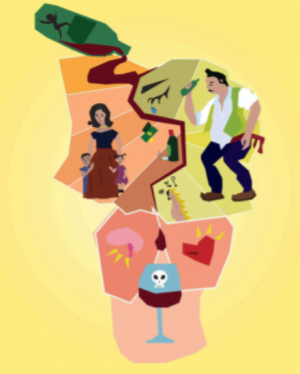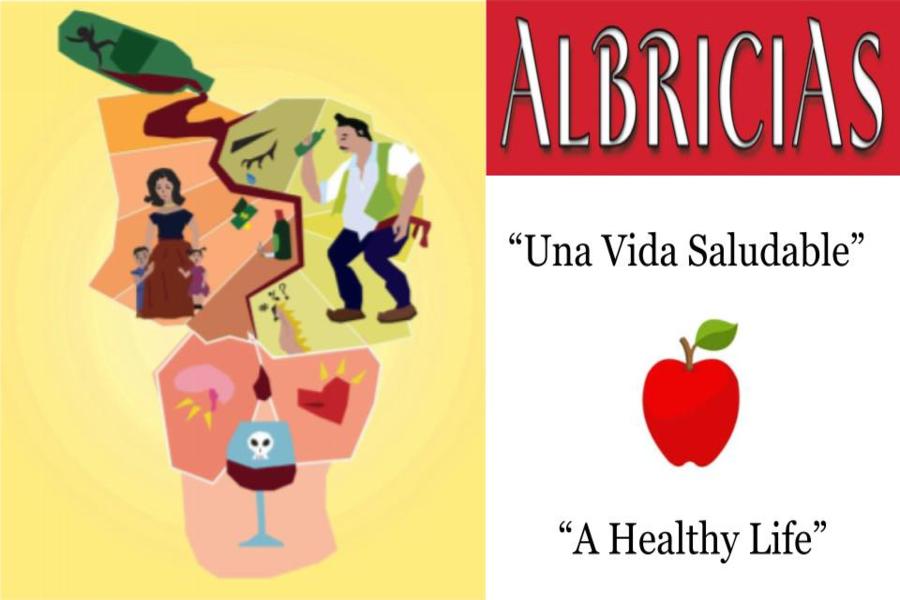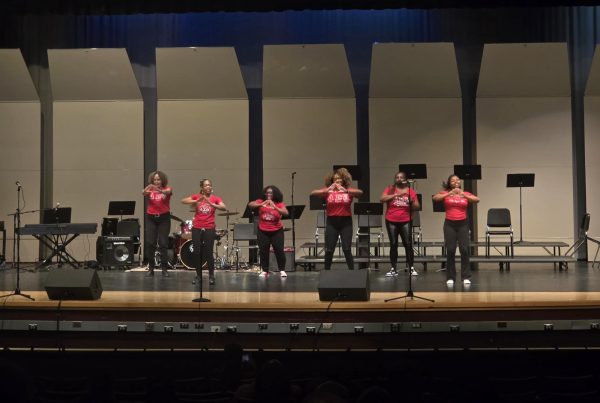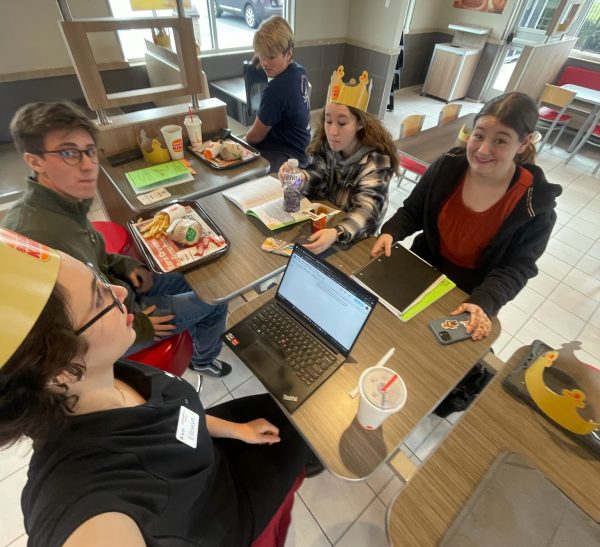Lancer Spotlight: “Active” Spanish Honor Society members published in national student journal
Nicole Golemboski, Galilea Cervantes Hernández, and Ella Haskins published work in the “A Healthy Lifestyle” edition of Albricias
Galilea Hernández’s artwork, “La Barrera del Alcohol” and the theme of the March 2021 edition of Albricias.
Every March and November, the American Association of Teachers of Spanish and Portuguese (AATSP), the sponsor of the Sociedad Honoraria Hispánica, publishes a student journal titled Albricias. This is a collection of essays, poetry, short articles and stories, photography, and artwork created by student members of the honor society across the nation. Each edition of Albricias has a theme.
The most recent issue, published in March 2021, had the theme of “Una Vida Saludable,” or “a healthy life.” This theme was inspired by the struggles we have faced maintaining an all-around healthy lifestyle throughout the COVID-19 pandemic. The submitted work focused on these struggles, as well as how we regularly promote health in everyday life.
Linganore’s Spanish Honor Society (SHS) chapter, Capítulo Antonio Gaudí, submits student work to Albricias every year as a membership requirement.
Spanish Honor Society advisor Andres Wright said, “I’m the fourth sponsor of the honor society, so the original sponsor was the one who implemented the Albricias requirement. The next few sponsors didn’t require submissions, but I decided to bring it back when I took over.”
This decision was made due to the fact that students are able to learn and study in a way that they determine.
“Albricias is a higher-level activity. It allows us to continue the use of Spanish, in writing an essay or creating artwork, and it also continues the study of Spanish culture in a way that is natural and is interesting to the students. The result is excellent work,” said Wright.
Spanish Honor Society president Valerie Ducos agreed that submitting work to Albricias is beneficial for members.
Ducos said, “Creating Albricias submissions is a great way to keep members creatively engaged in Spanish and to practice their writing skills in a way other than writing formal essays in class.”
This cycle, three members of SHS had their work featured in the journal. Nicole Golemboski, Galilea Cervantes Hernández, and Ella Haskins all had their submissions published.
Ducos said, “It is extremely difficult to be recognized among hundreds of other societies and submissions but this year, for the first time, all of our submissions were selected and published in the March edition of Albricias!”
There is a limit of three submissions per honor society, and it is uncommon to have even one selected for publication.
“We try to send in our maximum of three submissions each year. In the past, I believe we’ve had a total of four submissions published, so having three in one cycle was a great achievement!” Wright said.
In order to select which submissions to publish, the officers of the Spanish Honor Society had a meeting to vote on which they thought would be best. Ducos had narrowed the submissions down based on her knowledge of past pieces published in Albricias, but then got the other officers’ opinions on which they thought best fit the theme.
“Everyone interprets the theme in different ways, the main thing to look for is uniqueness and execution, what would stand out to the Albricias committee but still hold meaning beyond the simple theme. For art that is something eye catching, but with artistic meaning, and for poetry that is something well written, but not boring,” said Ducos.
“¿Una Vida Verdaderamente Saludable?”
Golemboski submitted a poem focused on mental health, titled “¿Una Vida Verdaderamente Saludable?”, or “A Truly Healthy Life?” in English.
“Generally speaking, my poem is focused on the various aspects of and ways to be healthy, in an attempt to highlight that health is not just diet and exercise, but an emotional and spiritual concept,” said Golemboski.
Her poem presented the dangers of attempting to pursue what society tells us is a healthy lifestyle and then compared this to the more important, psychological aspects of health.
She wrote, “Debemos darnos cuenta de que la vida no es sobre lo fuerte que eres físicamente, Sino que es sobre la fuerza de tu mente.” This translates to, “We must realize that life is not about how strong you are physically, Rather, it is about the strength of your mind.”
Golemboski wrote about her own personal experiences with the stereotypes and misconceptions of what it means to be healthy.
Golemboski said, “I think the inspiration for this poem stemmed mainly just from existing as an often unconfident adolescent female in today’s society.”
She also wrote, “En vez de obsesionarte con cuántas calorías están llenando tu estómago, Pregúntate cuáles pasiones y relaciones están llenando tu corazón,” which means, “Instead of obsessing over how many calories are filling your stomach, Ask yourself what passions and relationships are filling your heart.”
As her poem had a strong meaning to her personally, Golemboski felt especially proud when she found out her work had been published in Albricias.
“Like most people I am my own harshest critic so I think it was just a validating experience to be recognized for my creative and bilingual abilities. It is an honor to be published among such talented artists from across the country, “ Golemboski said.
“La Barrera del Alcohol”
Hernández created a digital art piece using Adobe Illustrator, a platform she learned to use in her computer graphics courses. Her artwork was titled, “La Barrera del Alcohol”, which in English means, “The Barrier of Alcohol.” Hernández decided to take the theme of “A Healthy Lifestyle” from a different angle, focusing on what can ruin a healthy life.

“The wine bottle that is spilling in the piece is the barrier that I mentioned. It is splitting the family apart, on the right side is the alcoholic father and on the left is the mother and children. The person trapped inside the bottle is the one having to fight this addiction, having no escape,” said Hernández. “On both sides there are small illustrations explaining the effects of alcoholism such as depression, scarcity of income, and physical abuse.”
Ultimately, Hernández portrays that this cycle of addiction will lead to the death of a family, and potentially, of a person. She found inspiration from the media around her, crediting her idea to the Kendrick Lamar song, “Swimming Pools”, which is about the effect of alcohol abuse.
Having her artwork published in a national journal was a huge achievement for Hernández.
She said, “I was ecstatic to find out my work was being published! The first thing I did was let my mom know, since this was the first time my artwork has been published in a magazine. I am just so glad this opportunity was presented to me. It has been one of the highlights of my senior year!”
“Detrás de la Máscara”
Haskins wrote a poem on the changes we have experienced to our concept of “health” as we live through the COVID-19 pandemic. Her work was titled, “Detrás de la Máscara,” which translates to, “Behind the Mask.”
“My work was about how before the COVID-19 pandemic, many had been focusing on their physical health and pushing mental health to the side,” said Haskins.
Haskins wrote, “Ahora, una vida saludable es lavarse, Distanciarse, Desinfectar todo. Ahora, es diferente que antes. Antes, una vida saludable era hacer ejercicio, Hablar con personas diferentes, Viajar.” This translates to, “Now, a healthy life is washing, Distancing, Sanitizing everything. Now, it is different than before. Before, a healthy life was exercising, Talking to different people, To travel.”
Haskins found herself struggling with the monumental changes brought about by the quarantine mandates. As an athlete, she was used to focusing on her physical well-being, but had to switch the focus to her mental health.
Haskins said, “I used personal experience to come up with this idea because I have dealt with increased anxiety rates, feelings of loneliness, and loss of motivation throughout this pandemic.”
She wanted to raise awareness about student’s feelings during the pandemic and emphasize the importance of mental health, comparing it to safety precautions such as wearing a mask and practicing social distancing. Haskins reassures teens that there is a light at the end of the tunnel and a way to maintain a healthy lifestyle in such a challenging time.
She wrote, “Ahora, es diferente. Pero, siempre hay una solución. Nuestras mentes deben estar sanas para vivir una vida saludable,” which translates to, “Now, it is different. But, there is always a solution. Our minds must be healthy to live a healthy life.”
The theme for the next publication is “La Diversión y Los Juegos,” or “Fun and Games.” The remaining members of SHS will be participating in this cycle.
Find these pieces in the current edition of Albricias, which is posted on the AATSP website. Haskins’ poem is on Page 11, Hernández on page 12, and Golemboski on page 14.
Your donation will support the student journalists of Linganore High School. Your contribution will allow us to purchase camera/recording equipment and software. We hope to raise enough money to re-start a monthly printed issue of our paper.













